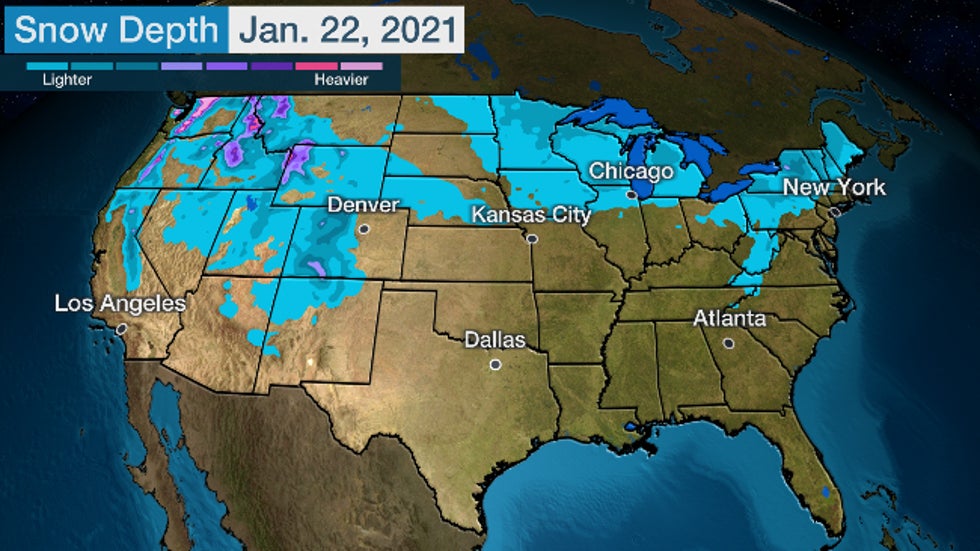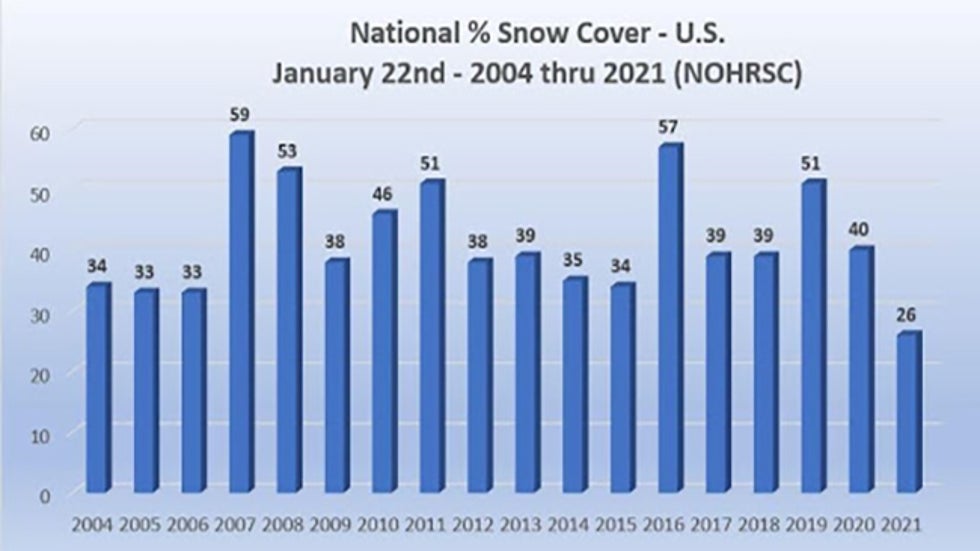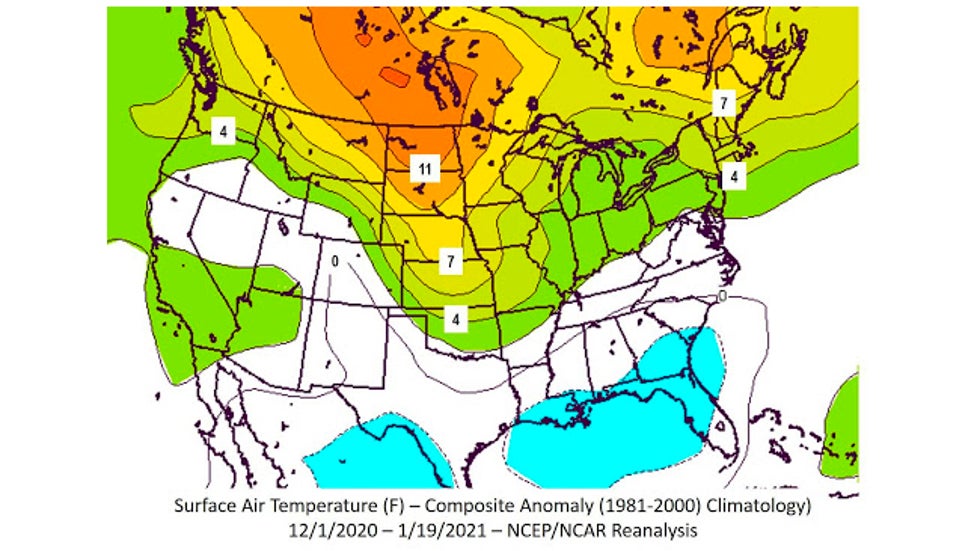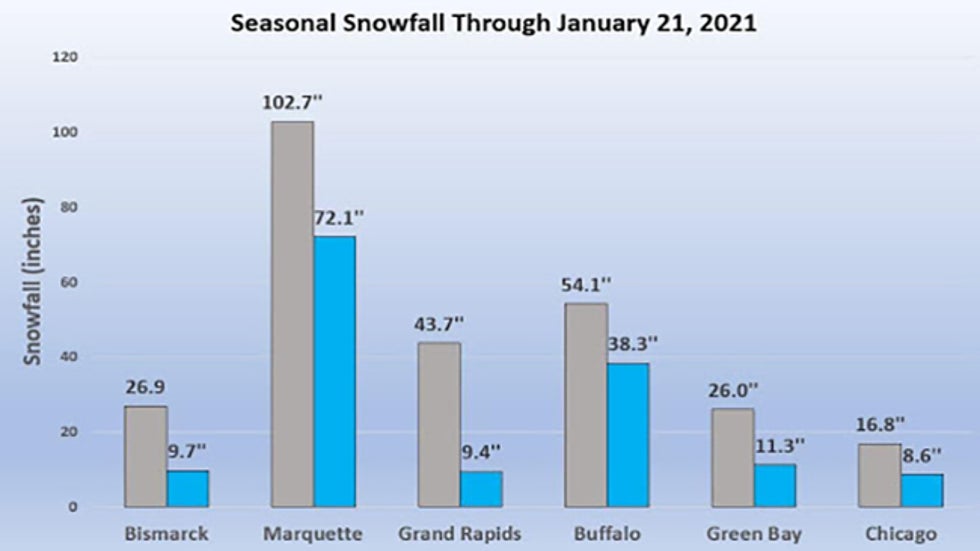Tom Niziol
 Snow depth analysis on Jan. 22, 2021, showed a relative lack of snow on the ground in the Northeast Urban Corridor, Ohio Valley and parts of the Northern Plains.
Snow depth analysis on Jan. 22, 2021, showed a relative lack of snow on the ground in the Northeast Urban Corridor, Ohio Valley and parts of the Northern Plains.If you live in parts of the northern tier of the nation right now, you might be wondering: where's all the snow?
It turns out the nation's snow cover is the least for this time of year in over a decade.
According to a satellite-based analysis from NOAA's National Operational Hydrologic Remote Sensing Center (NOHRSC), only 26 percent of the contiguous United States was covered by snow Friday.
That's the least expansive snow cover in the Lower 48 states for any Jan. 22 in the NOHRSC database dating to 2004.
 Percentage of the U.S. with snow cover on Jan. 22 from 2004 through 2021.
Percentage of the U.S. with snow cover on Jan. 22 from 2004 through 2021.While snow was on the ground as you'd expect in the heart of winter in the mountain West, upper Midwest, Great Lakes and interior Northeast, it was noticeably absent along the Northeast Urban Corridor as far north as southern New England; the Northern Plains, including much of the Dakotas; even into southern Alberta and southern Saskatchewan, Canada.
It’s not that Mother Nature hasn’t tried to bring snow to these areas.
The problem for snow lovers familiar with that beautiful white blanket is that even when it does snow, it won’t stick around for long because it’s been too warm.
Over a broad region of the northern U.S., but in particular the upper Midwest, temperatures have averaged well above average for the winter, with some locations seeing their warmest winter on record to-date. You can’t keep snow cover around with temperatures that warm.
 Temperature departures from average (degrees Fahrenheit) from Dec. 1, 2020, through Jan. 19, 2021. Much of the northern U.S. has been much warmer than average in winter, so far.
Temperature departures from average (degrees Fahrenheit) from Dec. 1, 2020, through Jan. 19, 2021. Much of the northern U.S. has been much warmer than average in winter, so far.One example of an area lacking snow cover during a very mild winter is Bismarck, North Dakota.
A metric developed to assess the severity of winter, the Accumulated Winter Season Severity Index (AWSSI), uses key parameters to rank the winter, including snowfall, days of snow on the ground and temperature.
Bismarck is having a record mild winter based on this metric.
The Great Lakes region is typically the snowiest area east of the Rockies.
The lake-effect snow machine turns on each winter season as cold air moves across the warmer waters to produce bouts of heavy snow across locations like Marquette, Michigan; Grand Rapids, Michigan; and Buffalo, New York.
But they are running snowfall deficits due to the lack of cold air to make snow.
Just west of the Great Lakes, Green Bay and Chicago are also seeing snowfall deficits, not only due to warmer conditions but a lack of favorable storm tracks to produce snow.
It’s tough to have a reputation for a rough winter in Chicago when they have had just over half of the snowfall (8.6 inches) as Amarillo (15.3 inches).
 Seasonal snowfall (blue bars) through Jan. 21, 2021, compared to the average-to-date (gray bars). Each of these cities has a significant snowfall deficit in the 2020-21 season so far.
Seasonal snowfall (blue bars) through Jan. 21, 2021, compared to the average-to-date (gray bars). Each of these cities has a significant snowfall deficit in the 2020-21 season so far.In the West, a prolonged drought over the Four Corners region of the U.S. has resulted in much less snow so far this season as well.
In fact, the Sierra Nevada Mountains in California are experiencing only 40% of the amount of snowpack they typically see thus far for the winter season. About the only area experiencing above-normal Snow Water Equivalent (SWE) is the Pacific Northwest and parts of the Northern Rockies.
 Snowpack percent of average, as measured by snow water equivalent, on Jan. 21, 2021. Much of the Western snowpack was well below average for late January.
Snowpack percent of average, as measured by snow water equivalent, on Jan. 21, 2021. Much of the Western snowpack was well below average for late January.Snow lovers should not fret, however – there is still a long way to go to recover.
First, we're heading into the peak time of year for major Northeast winter storms.
For parts of the Northeast and Plains, February is typically their snowiest month, according to analysis from Brian Brettschneider, an Alaska-based climatologist.
(MORE: How Much Snow Typically Falls After Groundhog Day?)
There are even parts of the Rockies and High Plains where March or April is their snowiest month, on average.
Furthermore, March or April is typically when the last snow of the season falls in much of the Northeast, Midwest and Plains.
All it takes is one storm track, with its attendant cold air, to lay down a footprint of heavier snowfall.
Apparently, the big question this season is “how long will it stay around?”
The Weather Company’s primary journalistic mission is to report on breaking weather news, the environment and the importance of science to our lives. This story does not necessarily represent the position of our parent company, IBM.
The Weather Company’s primary journalistic mission is to report on breaking weather news, the environment and the importance of science to our lives. This story does not necessarily represent the position of our parent company, IBM.

No comments:
Post a Comment